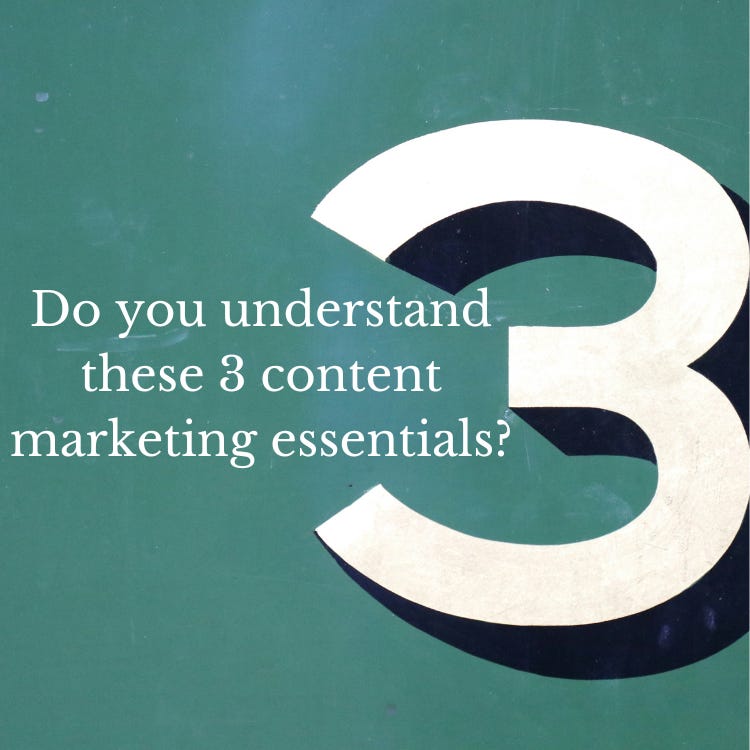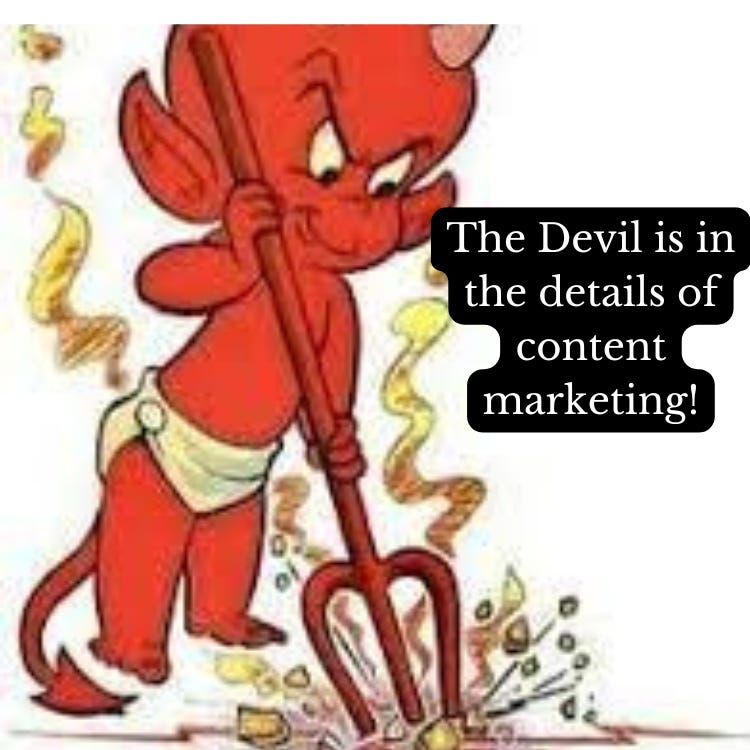3 Straightforward Content Marketing Essentials Everyone Should Know
You have to get these three things right for your content marketing efforts to have any chance of success.
Content marketing is a simple concept. Still, it can be confusing – especially as there’s ongoing confusion about “content.”
I’ll get to “content” at the end.
First, let’s focus on three essential elements that underpin every successful content marketing strategy.
I’ve done a lot of reading (and doing) about content and inbound marketing over the past twenty-plus years. While, yes, the doing requires deep thought, effort, and planning; conceptually it’s not a hard concept to wrap your head around.
Here are the three essential things you need to understand about content marketing so yours can do what this marketing strategy does so well: bring customers to your business.
Essential One: Purpose
You’re creating content for a purpose. Not just because it’s what all the cool kids are doing or because your competitor just launched a newsletter on Substack.
Purpose matters.
My purpose here is threefold:
Sharpen my writing skills and ideas as I learn.
Clarify my thinking (writing is thinking).
Share useful content marketing and writing advice that helps people and attracts clients to my newsletter and content marketing services.
Back when I edited a print magazine, the purpose was straightforward: provide information readers could use to do their jobs better.
Now that I’m focused on content marketing, the goal is similar—educate—but with an added layer: gently nudge my audience toward an action, like downloading a resource or making a purchase.
The purpose of your content may be different: maybe it’s purely for fun and entertainment, maybe it’s to help people get out of their own way, maybe you just want to write and share your thoughts and opinions with no expectations. As Simon Sinek would put it, start with why.
So, Essential 1: Your content must have a purpose. (And yes, if you just made a The Jerk “special purpose” joke in your head, you are my people.)
And while going viral sounds fun (and is fun, thought I’ve only had things go “viral” relative to the IDP industry), focusing on consistent, helpful content will serve you better in the long run.
Essential 2: Write Well
Writing isn’t magic.
It’s a skill you build with practice – like cooking. Not everyone’s going to be Gordon Ramsay or Emeril, but you can learn enough to whip up something your audience wants to consume and “tastes” good.
Anyone can learn to be good enough not to starve and even enjoy what you’ve cooked. Same with writing; it doesn’t have to compare to the great works of literature, that’s not your goal, it just needs to be good enough to grab the attention of the people you want to sell to.
And please, for the love of clarity, write like a human. Too much business writing is a jargon salad that leaves readers wondering what you actually do.
Scared of typos? Join the club. I’ve published millions of words and still cringe when I spot a “their/they’re” slip.
Typos happen. What’s worse is letting fear of imperfection keep you from sharing your expertise.
Also, don’t overcomplicate things. The curse of knowledge is real—you know too much, and that can make explaining things harder. Write as if you’re explaining it to your non-expert friend.
If your content makes your audience feel dumb, they’ll tune out.
I should add a caveat here: when writing for an audience of insiders, go ahead and use the insider lingo. If I’m in a roomful of marketers, I’ll use CTA without thinking about trying to explain it. Here, I’ll explain spell out call to action because not everyone knows the acronym. And a CTA is whatever the next action you want to move a reader to. My CTA at the end of this post is for my newsletter-in-a-box service, for instance.
Essential 3: Share It With the World
You wrote something. Great! Now what? Hitting “publish” and hoping for the best is like printing flyers and leaving them in a drawer. If you build it, they will not come.
Your audience isn’t hanging out in your head—they’re on LinkedIn, YouTube, email, TikTok, Insta, etc. Meet them where they are.
Distribution isn’t just about posting links. It’s about timing, platform, and understanding where your audience looks for answers.
While owning your list and real estate in an interested audience’s inbox, you still need to play the SEO game. Ignoring SEO is like opening a store and not putting up a sign.
I went into this in more detail in this post: Bark Like an Over-Caffeinated Chihuahua.
Content With Content
“Content” is one of those fun English words with multiple meanings and pronunciations. In marketing and publishing, content can mean blog, newsletter, ebooks, books, whitepapers, websites, emails, product descriptions, landing pages, infographics, video, movies, music, and I’m sure I’m forgetting a few.
I look at it like this:
Content is what you want to say. It’s the words.
Everything else is the container you use to package those words for sharing with the world.
It’s message and packaging.
That’s it.
Do Not Overthink This
It is WAY too easy to get lost in paralysis by analysis with content marketing.
You do need to do research – who are your customers? What are their major challenges? How does your product/service best help them remove their pain?
But at some point, until you actually begin to create and share content (blogs, videos, infographics – format doesn’t matter); you are just guessing.
You don’t know what will work.
So research.
Then start creating and sharing content. Evaluate how it performs. Adjust. Do it again.
Or as I often say: Lather. Rinse. Repeat.
I went into more detail on this here: Don’t Get Sucked Into the Content Marketing Virtuous Cycle of Doom!
The Essentials Are Simple, But the Devil’s in the Details
The devils (and gremlins) are in the details as you flesh out these three essentials:
Purpose
Write well
Distribute effectively
Simple, right? The execution, of course, is where the details—and the headaches—live. There are countless tools, platforms, and tactics you can explore. Just don’t let “more research” turn into procrastination. Focus on the basics first.
Your job is to create content that helps people. Make them laugh, teach them something, or solve a problem—and they’ll come back.
Schedule a time to talk, and let’s tackle your challenges together. With decades of experience in content strategy, marketing, and storytelling; I’ll help you refine your approach and create a plan that works. Let’s make progress, one step at a time!





Bryant, I like how you break this down into three simple steps. Also, you caught my interest when you mentioned your “ Newsletter in a box”. Could you briefly explain. Thanks